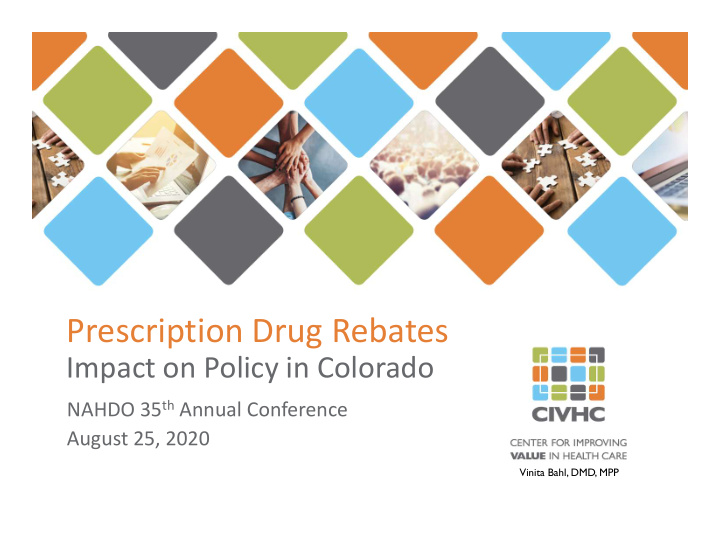



Prescription Drug Rebates Impact on Policy in Colorado NAHDO 35 th Annual Conference August 25, 2020 Vinita Bahl, DMD, MPP
Agenda • Introduction • Prescription drug rebates – how do they work? • Colorado initiative to collect rebate information • Findings by payer type with focus on commercial payers • Summary • Policy impact 2
Introduction • Prescription drug expenditures are the fastest growing consumer health care expense in the U.S., largely due to increases in prices • Measuring prescription drug expenditures is challenging because of lack of transparency about pricing and impact of manufacturer rebates and other compensation • Objective – present results of an analysis of drug manufacturer rebates and other compensation, and their impact on prescription drug expenditures in Colorado 3
Prescription Drug Funds Flow 4
Drug Rebates • Manufacturer rebates are paid to the PBM separately and often retrospectively, usually in exchange for favorable formulary tier placement and increased sales • Rebates reduce the retail cost of drugs but may produce a net increase in prescription drug expenditures, if rebates lead to increased utilization of higher cost drugs • Legal and market dynamics involved in negotiating rebates with drug manufacturers differ by payer type • Medicaid receives largest rebate as percentage of prescription drug expenditures, due to provisions of Medicaid Drug Rebate Program • Rebates for Medicare Part D typically larger than for commercial payers because formularies are more restrictive and manufacturer coupons for discounts at the point-of-sale are prohibited 5
Drug Rebates (continued) • Rebates for Medicaid and Medicare are reported publicly and used to reduce government subsidies and, in the case of Medicare, reduce premiums • Flow of rebates for commercial payers not transparent; not clear whether retained by PBMs and health plans or passed through and used to reduce premiums and out- of-pocket costs for employers and consumers • CIVHC analysis presents the first public information about rebates paid to commercial payers in Colorado 6
Drug Rebate Data Collection • As part of a state effort to constrain health care costs, payers required to submit prescription drug rebate information to CIVHC each year beginning September 2019 • First submissions included rebate data for three years: 2016, 2017 and 2018 • CIVHC modeled data submission requirements after a program administered by the Center for Health Information and Analysis (CHIA) in Massachusetts • Payers submitted prescription drug rebate files based on data from their PBM • Prescription drug expenditures excluding rebates, in total and by type of drug (specialty, non-specialty brand and generic) • Prescription drug rebate amounts, in total and by type of drug 7
Drug Rebates by Payer Type Note: Graphic modeled after format presented in the CHIA Annual Report of Performance of the Massachusetts Health Care System 8
Drug Rebates for Commercial Plans Prescription drug rebates increased $60 M (50%) over three years, which significantly reduced the size and growth of total drug expenditures 9
Drug Rebate Variation - Commercial Plans Rebates as a percentage of total prescription drug expenditures exhibited significant variation across payers in each year Note: Graphic modeled after format presented in the CHIA Annual Report of Performance of the Massachusetts Health Care System 10
Rebates by Drug Type for Commercial Plans Increase in rebates highly correlated with increase in total spend for both specialty and non-specialty brand name drugs; rebates for these drugs grew $59 M from 2016 to 2018, but spending increased $100 M -14% 9% 18% 15% 42% 68% 33% 30% 43% 11
Summary • Prescription drug rebates are substantial and have the effect of reducing both the size and growth of overall prescription drug expenditures • Rebates for Medicaid and Medicare are used to reduce government subsidies and, for Medicare, to reduce premiums • Unclear if commercial payers pass rebates on to employers; if not, employers paying full price of increasingly more expensive drugs • Increases in drug rebates linked to increases in expenditures for higher cost specialty and non-specialty brand name drugs • What is impact of rebates on the price of individual drugs? • To what extent do rebates increase utilization of high priced drugs and reduce utilization of lower priced alternatives? 12
Drug Rebate Impact on Policy • Policy prescriptions emphasize manufacturer drug pricing transparency and pass-through of rebates to offset employer drug expenditures • Colorado General Assembly pursuing legislation to address the high cost of prescription drugs • Ensure rebate dollars are passed through to employers (HB20-1160) • Increase transparency in manufacturer drug pricing (HB20-1160) and production costs (SB20-107) • Expand a program to import drugs from other countries (SB20-119) • Sound alerts about large cost increases for individual drugs (HB20-1160) 13
Center for Improving Value in Health Care, Colorado (www.civhc.org) 14
Recommend
More recommend